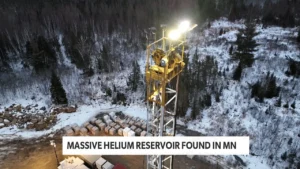
Massive Helium Reservoir Found in Minnesota
min read
Christina Thompson (Anchor, EarthxNews): Researchers say they’ve discovered what could be the largest reserve of helium in North America at a drill site in Minnesota. Resource exploration company, Pulsar Helium, confirmed large deposits of the highly sought-after gas were found around 2,200 ft below the ground in the northern part of the state.
The company said the helium concentration measured close to 14%, which is roughly 30 times the industry’s standard for commercial helium use. The discovery has scientists and researchers rejoicing because helium is used as a coolant for nuclear reactors, rockets, and medical diagnostic equipment. Industry analysts say the natural gas is in short supply. Joining us now to discuss is the head of the drilling company behind the discovery, Thomas Abraham-James, CEO of Pulsar Helium. Thomas, thank you so much for coming on. Can you tell us a little bit more about this recent helium discovery in northern Minnesota?
Thomas Abraham-James (CEO, Pulsar Helium): Thank you very much for having me. And yes, it’s all very exciting. In February, we went and drilled what’s called an “appraisal well,” so confirming the original discovery. We went deeper – 2,200 ft – and we’re getting gas readings, helium concentrations up to 13.8%, which makes it the highest concentration helium discovery in North America. So now we do everything possible to really realize its full potential and try to get it into production as quickly as possible.
THOMPSON: Just how rare is a find like this?
ABRAHAM-JAMES: Well, historically and today, helium is a byproduct of natural gas. And it’s only because of its scarcity – and the increased price in the commodity – that now people like Pulsar, companies like us, are out there, exploring for it. So it is very limited in its locations, but North America is one of the places. And also, being the largest consumer of helium, the USA is the right place to be.
THOMPSON: So what makes helium such a sought after gas? What can we use it for?
ABRAHAM-JAMES: Can’t substitute it for anything. It’s inert, and it’s the only thing that’s a liquid close to absolute zero or at absolute zero. So really, you can use it for anything – which is MRI scanners, for semiconductor manufacturing, for artificial intelligence computing, space launch. It’s probably worth noting that party balloons is about 3% market share and probably a waste of a very valuable commodity.
THOMPSON: From what I understand, there is a lot of helium out there, just not necessarily on Earth. Why is that?
ABRAHAM-JAMES: Well, just like that party balloon analogy, it likes to escape. So as soon as it gets up to the atmosphere, it then disappears and goes somewhere else. So finding it in concentration in the Earth’s crust is quite difficult, where it’s entrained in that. But that’s what we specialize in. And we think that in Minnesota, we’re onto something very good there.
THOMPSON: From both a geopolitical, as well as a supply chain standpoint, what is so beneficial to this find, this reservoir in North America?
ABRAHAM-JAMES: Being the largest consumer of helium, having it in the USA’s backyard, is key. The other thing is that helium doesn’t like to be transported. So if it’s coming from abroad, it will inevitably leak at some point in time. So the closer it can be to market is optimal. And then of course with the geopolitical scene now – with shipping routes being closed down for geopolitical reasons – it makes it even more important to have a domestic source of helium for the US. Much like other key commodities that people have talked about, rare earths coming from Asia and so on. So for something so important – for, say, computing and the technology we rely on – to have the USA’s domestic supply really is key.
THOMPSON: So your company found this helium. What’s next?
ABRAHAM-JAMES: What’s next is that we’ve just really completed what we’d call “phase 1.” So we found it there; the gas is present; we know it’s high concentration. So now, we’ve gone on to see what are the flow rates? What does a production plant look like? And we’ve got a very capable team and we’ll be moving forward with that. Also, I must admit, with a very supportive local community in Minnesota as well. So I think they’re in a good place to try and reach its potential sooner rather than later.
THOMPSON: That’s awesome! In a perfect world, what do you want to see happen with this helium?
ABRAHAM-JAMES: I’d like to see stability brought to the helium market. I mean, really, a lot of the ones who you could say are sort of lower down the food chain – which is, sadly, research and medical – they really find it very difficult to obtain the helium that they need to do their work. So if we can bring stability and decrease that risk of, you know, not being able to have an MRI scan, I and my colleagues would take a great deal of pleasure in that.
THOMPSON: That’s wonderful. Well, we need more people like you Thomas Abraham-James! Thank you so much for coming on.
ABRAHAM-JAMES: Thank you for having me.
